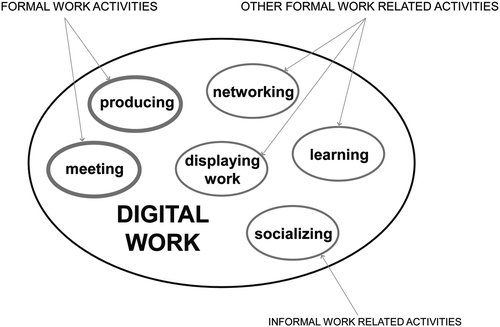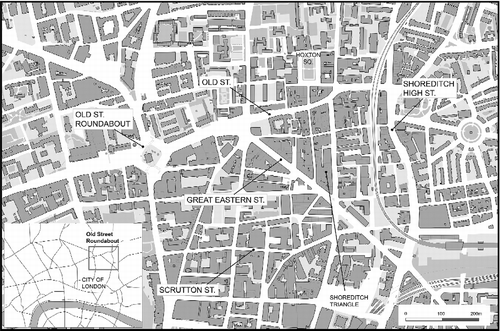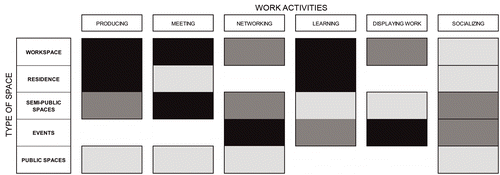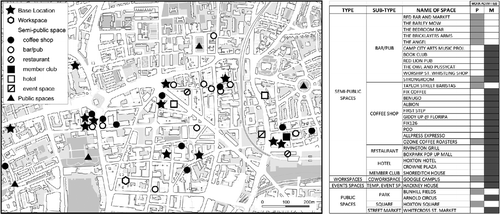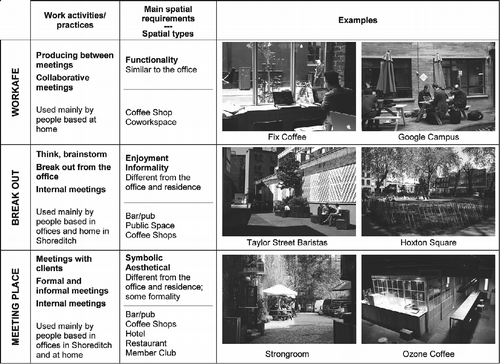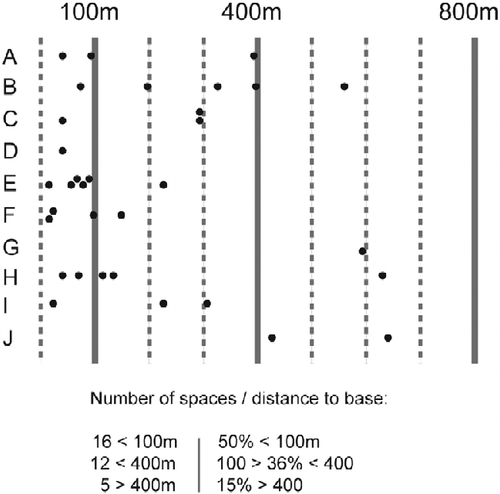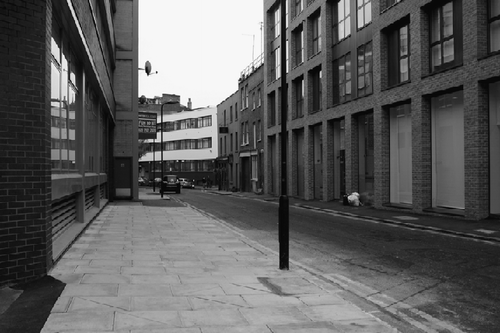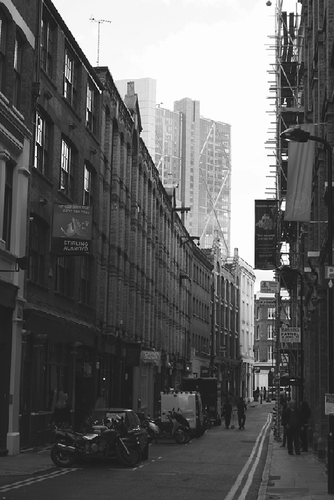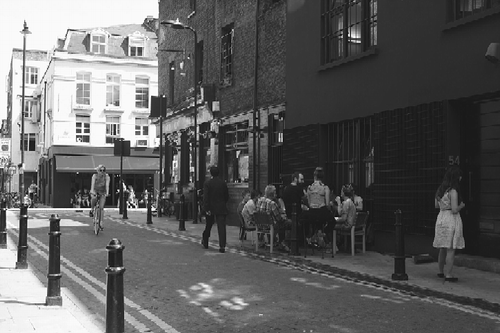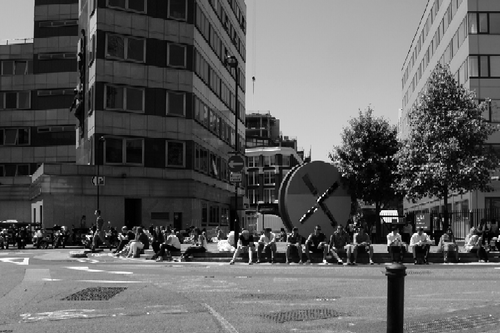Abstract
This paper examines the relationship between space and the digital industries through everyday work practices in Shoreditch, London. Drawing on interviews with digital workers, the paper examines how work unfolds in multiple settings and how the built environment supports these work patterns. Digital work extends from the office or the residence (the base) to multiple settings (ancillary spaces) in what can be defined as an extended workplace. The study identifies micro and macro scale characteristics of the built environment that are relevant (spatial characteristics of semi-public and public spaces, access and control, location, and attributes of the neighbourhood) expanding the understanding of why and how place matters for these industries. A typology of ancillary spaces and some reflections on policy implications are advanced.
Introduction
‘Silicon Roundabout’ is an emergent cluster of digital firms around Old Street Roundabout, Shoreditch, East London (Foord Citation2013). Since it was nicknamed by Matt Biddulph in 2008, the area has received increased media and political attention, particularly with the set up of the Tech City Investment Organisation in 2011. Previous research examined how such clusters of digital and other creative industries in inner-city areas relate to the character of place regarding processes that influence location and co-location (Pratt Citation2002; Currid Citation2007), the role of place in individual creativity (Drake Citation2003), and the spatial characteristics of urban areas where they concentrate (Hutton Citation2006; Rantisi and Leslie Citation2010). These studies have shown that place and specific spatial conditions matter for the operation of these industries. However, empirical evidence remains limited regarding distinct spatial patterns across industries and the concrete spatiality of these processes.
Taking an alternative production-centred perspective (Indergaard Citation2013), this paper develops a new approach in this field of enquiry by examining these relationships through everyday work practices of digital firms. Where do digital work activities take place and how does the built environment support these work patterns? The focus is on how work activities unfold in multiple settings. This range of semi-public and public spaces is then used to explore how the built environment, at several scales, accommodates digital work. Digital industries, such as software development and web-based services, are particularly relevant in this debate because they both use and develop technologies that supposedly challenge the importance of place in economic, social and cultural activities; Silicon Roundabout provides a key case for investigating them.
This study offers an empirical contribution on two levels. First, by examining these relationships through work practices, it identifies a wider range of spaces that are used by these firms expanding the understanding of how and why they are relevant. It shows that digital work extends from the office or the residence (the base) to multiple settings (ancillary spaces) in what can be defined as an extended workplace. This extension is limited and mediated by the nature and requirements of digital work; but this network of spaces plays a critical role in supporting these workers' needs. Second, it provides a pioneer analysis of the spaces used for digital work in Shoreditch and identifies elements of the built environment that support these patterns: spatial characteristics of semi-public and public spaces, access and control, location, and attributes of the neighbourhood. Findings confirm that place matters for these industries; but they offer a more detailed and nuanced view of significant spatial characteristics and highlight the role of neglected aspects related to access, control, and activity patterns, calling for more specific accounts of the relationships between space and the creative economy.
The paper shows that the place of digital work is not the electronic cottage (Toffler Citation1980) but, to some extent, the public realm. This is of particular interest for urban design and policy; work is one of the overlapping human activities that occurs in (and constantly redefines) the public realm and for which the built environment needs to be planned, designed and managed. A better understanding of how the latter supports digital work practices may offer a contribution for rethinking policies that aim to nurture creative industries.
Creative Production, Place and the Spatiality of Work
Approaching Place in the Urban Creative Economy
Scholarship on the relationship between place and the creative economy stems from distinct conceptual and empirical bases (Pratt and Hutton Citation2013). Arguably, the most influential is Florida's Creative Class theory (Florida Citation2002). It asserts that a highly mobile group of people (Creative Class) are “purveyors of creativity” and that “creativity is the driving force of economic growth” (Citation2002, xxvii); cities and regions should thus be made attractive to the Creative Class to foster urban economies. Their locational choices, however, are not restricted to economic considerations but are also associated with lifestyle and thus place: “Place itself, I began to realize, was the key factor. So much so, that I coined a term—quality of place—…to cover the unique set of characteristics that define a place and make it attractive” (Florida Citation2012). ‘Quality of place’ factors include amenities (such as cafés, restaurants, diverse night-life experiences and outdoor activities), vibrancy of street life, authenticity and diversity.
A burgeoning literature has convincingly critiqued this approach from social, economic and policy perspectives (Peck Citation2005; Pratt Citation2008; Krätke Citation2010). Nonetheless, also with respect to the role and attributes of place in the creative economy, it has several limitations. For Florida place is an asset to attract the Creative Class; ‘quality of place’ is thus conceptualized as the perceived preferences of a particular group of people. This is a restricted (and elitist) view of what ‘quality’ means in respect to ‘place’, even if some of the socio-cultural qualities included may “enhance the cities' or regions' quality of life in general” (Krätke Citation2010, 16). Of particular importance for this paper is that this approach focuses mostly on consumption and does not address creative production; it thus “obscures an analysis of the way the built environment cultivates or nurtures creativity” (Rantisi and Leslie Citation2010, 2826). Moreover, the region/city scale of analysis is too generic, overlooking the specific characteristics of the areas where these industries concentrate and how these support their operation and development.
A more promising avenue to examine these relationships is offered by productionist approaches which examine the cultural and creative industries as an economic sector (Scott Citation1997; Pratt Citation2008; Indergaard Citation2013). In this view, “human capital is not a trigger of urban development as its significance depends on how it is mobilized in a particular productive configuration” (Indergaard Citation2013, 44). Space is part of this productive context (Pratt Citation2008). New media industries, for example, have a tendency to cluster in particular places; these locational dynamics are associated with specific organizational forms and production processes. As these industries operate upon face-to-face contact (for example, for specific knowledge exchanges) and social networks, proximity is key to support these patterns of interaction (Pratt Citation2013).
A critical aspect of the relationship between these production processes and space is that social practices are a critical part of work and take place, not only inside offices, but also in public and semi-public spaces. This suggests a reconceptualization of what constitutes work and an extension of the workplace. Increasingly sophisticated devices that facilitate mobile work expand the frequency and diversity of work activities performed in multiple spatial settings, suggesting that also more common work tasks may further embed production in urban space(s). Distributed work, and extended workplaces, as coined in this paper, are not new phenomena and are not exclusive to these firms (Harrison, Wheeler, and Whitehead Citation2004). However, work patterns found here suggest that a structured focus on the spatiality of everyday work practices can further inform an analysis of how creative production happens in space; and thus it can complement production-centred analyses in expanding the understanding of where and how place is constitutive of a productive configuration.
Spatial Characteristics of Creative Neighbourhoods
Studies of creative production neighbourhoods have shown that specific spatial characteristics matter; these provide both material and symbolic resources, operating at a variety of scales and often in combination (Lloyd Citation2004; Hutton Citation2006). A review of this body of work depicts key spatial elements identified across a range of industries as well as the debates and limitations of existing literature.
Aesthetic qualities of the built environment are noted as a source of inspiration (Drake Citation2003) and linked to processes of identity formation of workers and firms (Lloyd Citation2004; Hutton Citation2006). The type and scale of buildings is relevant to provide spaces suitable for work, associated practices and live/work. Heritage buildings often present in these areas offer both appropriate spaces and a perception of authenticity (Hutton Citation2006).
Urban-design features are considered important for supporting patterns of interaction critical for these industries. Density, public spaces and streetscape character “enhance a sense of intimacy central to the creation of an underground economy that depends on low-cost, word-of-mouth networking to exchange codified information [and] the more sticky, tacit kind” (Rantisi and Leslie Citation2010, 2837). South Park, in San Francisco, is seen as a site “of informal and chance face-to-face interaction particularly of an inter- or cross-firm variety, between new media workers” (Pratt Citation2002, 42). Montgomery included legibility, permeability and an active street life as critical characteristics of cultural quarters which are “expected to have a more active and discernible public realm than is generally found in urban environments” (Citation2003, 300).
Semi-public spaces such as cafés, bars and restaurants play a diversity of roles, in addition to supporting creative consumption patterns. The relationships between these spaces and the character of the urban environment has been noted by Montgomery (Citation2007, 355) who stressed that a vibrant evening economy, including café culture, is critical to “generate a more dynamic and varied street life”. These settings are also seen as sites for work, particularly meetings (Rantisi and Leslie Citation2010) and chance encounters (Nathan, Vandore, and Whitehead Citation2012). They are often perceived as third places (Oldenburg Citation1997): “Club Social [Mile End, Montreal] is an example of such a ‘third space’. As a microcosm of the neighbourhood, the café is a dense, accessible, and affordable site: that is, one that breaks down boundaries” (Rantisi and Leslie Citation2010, 2838).
Few authors have provided more detailed accounts of the role and characteristics of these spaces. For Heebels and van Aalst (Citation2010) their significance as sites for establishing contacts holds true only for specific groups of entrepreneurs (starters and experimenters). Lloyd (Citation2004) pointed out that semi-public spaces in Wicker Park, Chicago, also played an important role in providing additional employment opportunities for the artists to supplement their income. Moreover, he stressed the role of a “quasi-public space”—Urbus Orbi Café—that is “apparently a space of leisure” but “contributed to the real work of artists by facilitating interactions and collaborations” (Citation2004, 356). His analysis raises two further points. First, the “ideological commitment” (Citation2004, 354) of the owner in allowing artists to stay regardless of consuming (he claimed to be inspired by Oldenburg's concept) unravels the role of providers in co-producing these spatial settings. Second, the café “did not meet Oldenburg's (overly simplistic) criterion of being a social leveler welcoming to all—like bohemia in general it was cliquish and exclusive” (Citation2004, 354), calling for a closer examination of how these spaces operate.
These studies show that place and specific spatial characteristics matter; but empirical accounts of the diversity of spatial patterns in different industries remain limited. More importantly, the concrete spatiality of these processes is under-researched and there is ground to further investigate how specific spatial practices involved in creative production are mediated by the built environment. Brennan-Horley (Citation2010) explored the spatial extension of creative work providing an innovative account of the sites that constitute the geography of the creative industries. However, the spatiality of everyday work practices of digital workers can further expand this understanding, not only regarding relationships between locations at the city scale but also more detailed relationships between the built environment, its characteristics and creative production.
Research Strategy and Case Study Area
In order to investigate the spatiality of everyday work practices, digital work was defined as a set of six activities (Figure ). This paper examines two of them: producing and meeting. For digital workers, producing includes practices such as writing code or developing ideas, and meeting encompasses encounters of several types with people such as clients and colleagues and forms of collaborative work. Focusing on these activities provides a way to examine spatial patterns associated with the core of ‘doing work’.
There is no agreement on a precise definition of digital economy (Department for Business Innovation and Skills, Department for Culture Media and Sport, and Intellectual Property Office Citation2010) and existing definitions present several limitations (Nathan and Vandore Citation2013). The study focuses on a restricted set of digital industries that include: software development, online based services and products, and a range of digital services including ‘creative digital firms’ as described by Foord (Citation2013).
Drawing on a larger study, data for this paper were collected through three methods: semi-structured interviews with people involved in these digital industries (n = 17), observation of semi-public and public spaces in the case study area, and secondary data (maps, reports, websites). Interviewees were selected using purposive sampling to maximize the diversity of work patterns. Four criteria were used: firm type (size and stage of development); role in the firm (included managers, developers and others); workspace type (included residence and individual and shared offices); workspace location (majority in Shoreditch but also based elsewhere and using the area). The interviews aimed to understand patterns of space use in each work practice as well as the perceived relevant spatial characteristics and were structured around five spatial types (residence, workspace, semi-public spaces, events and public spaces).
The most inclusive mapping of the cluster identified over 1500 digital businesses in Clerkenwell, Hoxton and Haggerston (see Nathan, Vandore, and Whitehead Citation2012 for further details). This study focuses on a key area around Old Street Roundabout where most firms are based (Figure ). Located north of the City of London, the area is a hotspot of creativity in London (Pratt Citation2009) and a centre of nightlife activity. The urban structure has a marked contrast in scale with large and busy roads defining zones of small streets with an intimate feeling. There is a mix of building types, with the presence of heritage structures due to its industrial past. This is an area in transition (Foord Citation2013), where empty sites sit along new developments, providing ground to explore processes of appropriation by a growing number of digital firms.
The Extended Workplace: The ‘Base’ and Ancillary Spaces
Analysis of the spaces used for the six work activities indicates that work in digital industries extends beyond the main workplace, whether this is an office or a residence. Interviewees make use of multiple settings to work, including residences, workspaces, semi-public spaces, events and public spaces (Figure ). Rather than suggesting a detachment to particular settings and space types, these patterns show that the degree of extendedness is mediated by the nature of digital work and individual characteristics of workers. The extended workplace may thus be understood as a network of spaces used to work in different ways and contexts. Producing and meeting are key work activities for these firms, revealing the core structure of this workplace; spaces operating as base and others as ancillary spaces, the complementarity between these settings, and the critical role that both play in supporting the diversity of work patterns and needs.
The importance of the base is depicted in producing. Whilst interviewees use a range of spaces for this activity, most use mainly the office and home, depending on being based in a workspace or not. In fact, except for one, all workers based in an office reported this pattern of use. One founder said: “I'm in the office, probably nine days out of ten”. Productive work often requires equipment, work infrastructure and an appropriate setting to concentrate and perform those tasks. Moreover, producing may require isolation or the presence of other people. In offices, a key element is co-presence of workers that allows for face-to-face communication, relevant for a set of work practices, and for more or less planned forms of interaction. These requirements for ‘doing work’ help to explain the attachment of digital workers to a space to work, to the base, and show that the office is still important in digital production.
However, ancillary spaces (semi-public and public spaces) play a critical role as a complement to the base. In producing, their use is occasional and associated with specific work tasks and contexts. One worker summarized: “When I really have to think about something and just make a decision, I could just maybe take a walk or go somewhere else … and then when I actually do the work it's at work”. In meeting, a distinct pattern emerges; the majority of interviewees said they used ancillary spaces and more frequently. For workers based in offices, whilst the base is important as a setting for internal and client meetings, particularly when they involve proper work, alternative spaces are used in a variety of contexts. For workers based at home, the use of these settings is a necessity. None of them mentioned the base as a place for meetings and all used semi-public spaces for practices such as collaborative work and more formal meetings. The residence is not a suitable place for this activity; it is too private and often there is no separate and equipped space for meetings. Semi-public spaces thus provide an affordable and adequate alternative.
These work patterns suggest that the use of multiple spaces is associated with the diversity of practices involved in each work activity and their distinct spatial requirements. Three main factors are relevant: the type and purpose of work, the level/type of interaction involved, and the time/context. The advantages and limitations of each space type in relation to the requirements of these work tasks are critical to understand how the extended workplace operates in digital production.
The Use(s) of Ancillary Spaces
Ancillary spaces are used for producing and meeting for a variety of reasons and in different contexts. In producing, interviewees used mainly semi-public social spaces (coffee shops, pubs and hotel bars), but also other types (library, member club, co-working space). Interestingly, public spaces were mentioned by few interviewees and as an exception.
Workers based in offices use these settings for practices such as a change of scenery, to think or brainstorm. These spaces offer an alternative environment to the office, thus providing a ‘special’ space for these practices. Not surprisingly, workers based at home mentioned a more diverse set of semi-public spaces. Their use is associated with coping with home working. Reasons mentioned by interviewees included the desire to separate work and personal life, be around other people, and the need for stimulation. One founder said:
I get really bored at home … There's no one to talk to … also, to keep that motivation, is quite tough when you're just sat there on your own. Sometimes, I'll just say go off to a coffee shop … and have a walk into town, have a change of scenery for a couple of hours, take my laptop, or just take my notebook and work from there for a little while.
Ancillary spaces are also used between meetings; moving around for appointments takes time and these settings offer a way to minimize unproductive periods. These spaces are thus fundamental as a complement to home workers' needs.
The majority of spaces used for meetings are semi-public spaces. The coffee shop is the most important space with only three interviewees not reporting their use. Other spaces included bars/pubs, members clubs, restaurants, hotels and a library. Public spaces are not a common place to meet, but few interviewees mentioned them.
Workers based in offices seek alternative spaces to create a different atmosphere for meetings, have more privacy, and leave the office for some time. Ancillary spaces support specific needs that the office is not able to and play an important role as complementary to this base.
Several interviewees described how meetings in ancillary spaces convey a specific image of the firm or create an environment for a particular encounter. One reported an introductory meeting with a client in a pub “to have a more informal chat”. This setting is used to create a context of informality appropriate for that meeting. Moreover, as he added, semi-public spaces are also “a more neutral space” if compared to workspaces and thus perhaps more adequate for that phase of the business. These spaces were also mentioned for internal meetings. One founder said that occasionally they use a meeting room at the Hoxton Hotel: “If it's something important, we'll go there … Just to give something a sense of occasion, if it was a big announcement or something like that, even to the staff”. These examples suggest that space does not play solely a functional role but also an aesthetic/symbolic one.
Two cases illustrate other uses of ancillary spaces. One founder, based in a shared office, reported the use of a hotel to hold meetings related to their acquisition in order to keep them private. He explained that otherwise people in the office would realize the on-going process and eventually disseminate it. Another interview mentioned a public space, Arnold Circus, to do informal internal meetings and thus take an opportunity to leave the office. The type of work is particularly relevant in this case. He said:
It's great for meetings where you don't need equipment … things like where you literally go there with little notebook and a pen and you just take notes manually. We don't really take the laptop, because then you need internet … and also … having a screen in the sun doesn't really work.
Interviewees based at home use ancillary spaces for meeting clients and mentors, for example, but also for collaborative work meetings. This is well-illustrated by founders of early stage start-ups who often work with several people in the development of the business. Whilst semi-public spaces are generally less suitable for work-based tasks, coffee shops, pubs and members clubs were mentioned as settings for collaborative practices; they function as a complement to the home offices and as an alternative to more expensive meeting rooms. In addition, some of these workers use ancillary spaces for other reasons; one freelancer said he went to the Café at Google Campus because several friends worked there: “It's good for me to check in on their businesses and see what they're doing and hear their stories”.
These examples show the variety of ways in which ancillary spaces support the needs of digital workers. In some cases, they contribute to improve the quality of work life; in others, they are fundamental to complement the base and accommodate these work patterns.
The Role and Characteristics of the Built Environment
Ancillary spaces are settings where work interweaves with public life; thus they are privileged lens through which to further examine how the built environment facilitates digital work patterns and is being adapted to accommodate them. This section develops this analysis, focusing on the spaces used by interviewees for producing and meeting outside of their base in Shoreditch. It shows that micro and macro scale characteristics of the built environment are relevant. First, a range of spatial characteristics of ancillary spaces (internal and external configuration, work infrastructure and look and feel) support distinct work practices, and a typology is proposed to describe these settings; second, access and control of space are critical for issues of space availability, work and social atmosphere, and management of multiple uses; third, location of spaces matters and is associated with walking distance and accessibility; finally, the uses, density of activity, and structure, scale and style of the built environment contribute to further facilitate these work patterns.
Unpacking the Ancillary Space: Typology and Spatial Characteristics
Interviewees mentioned 32 ancillary spaces for producing and meeting in Silicon Roundabout (Figure ). Most places are used by people based in the area but few are also used by people based elsewhere.
Distinct spatial characteristics of these settings support different work practices. A typology of these spaces is useful to understand and describe them. Three main types were identified: the workafe, the break-out space, and the meeting place differentiated by the type of work practices performed in them and their main spatial requirements (some settings are hybrids). Figure summarizes the proposed typology showing the relationships between the ‘ancillary type’, common work practices, requirements and spatial types.
The workafe includes the spaces used for autonomous and collaborative work of a more proper nature. These are mostly coffee shops and their distinct characteristic is providing good conditions for these work activities for people on their own or groups; a place that almost mimics an office environment. Spatial configuration, work infrastructure and working-type atmosphere are key elements in creating these conditions.
Fix 126 in Curtain Road and Fix in Whitecross Street illustrate these characteristics. Both have features of a working environment in terms of space and micro-scale conditions for work. The large windows to the street and location of sitting areas close to the openings maximize natural light, creating a space that is pleasurable and suitable for work. They are open plan spaces but offer distinct areas that cater to a variety of work practices. In Fix 126, these are achieved through level differentiation and short walls, defining an area with a low table suitable for meetings. In Fix Coffee, four types of tables/seats define distinct zones and support diverse work tasks and needs. The layout and type of furniture are important as one interviewee explained:
I think the ones I've seen that do it well, they have a bunch of different types of spaces you can sit in. They have couches, which are more for chatting … they have tables with a bunch of chairs, it's almost like a meeting space. They have individual laptop areas … they're already providing for all the different types of activities you could technically do there if you're working.
Work-related infrastructure is also relevant. Elements mentioned by interviewees included internet provision and availability and location of plugs. Moreover, both spaces provide other features such as appropriate lamps. These micro-scale elements are important from a functional point of view but also in what concerns creating a working atmosphere. As one founder said: “There are some spaces that say that they are work spaces, but look too much like a restaurant and I don't really want to go sit in a restaurant for hours”.
In terms of their relationship with the street and exterior spaces, Fix premises are permeable to the outside, not only through areas of transparent façade but also because they make use of adjacent exterior spaces. Fix Coffee has a terrace area on a side street and Fix 126 has outdoor benches, aligned with the façade. Their corner location reinforces the spill out of activities to the urban environment. In contrast, in Ozone Coffee, visibility is denied by a white semi-transparent element put on the large areas of glass. Whilst this brings in natural light, there is a clear intention of creating a more private setting. The Café at Campus makes use of the inner courtyard of the building offering an exterior space to work.
The workafe is also a product of the action of providers; two spaces illustrate how spaces are being adapted to accommodate these work patterns. El Paso is the most extreme example of a bar that is trying to promote the use of its premises for work during the day whilst keeping its evening use. It advertises as a bar, workplace and diner for “the modern nomadic worker with enhanced comfort, productivity and opportunities to interact” (Design stories Citation2011). The project employed a set of strategies to adapt the space taking into consideration the elements identified above. A residency space, which it is allocated for a few weeks and resembles an office, is strategically placed facing the street in order to make work visible to the outside and thus attracts other nomadic workers. The Café located in the basement of Google Campus, a multi-use facility that opened in 2012, is operated by Central Working. This is a non-dedicated co-working space, with tables designed for work and informal meeting areas. It is described as “the perfect space to socialise, hold meetings or get on with your work” (“Workspace—Campus London” Citation2013) and provides a paradigmatic example of the workafe.
The ‘break-out’ type encompasses spaces used for less work intensive tasks such as informal internal meetings and exceptions in the work routine, often during working hours or after work. These tasks have few spatial requirements in functional terms; above all, these spaces offer an environment that is different from the office, a place to escape physically but also mentally. Interviewees described qualities of these spaces related to outside areas, quietness, and mix of play and work.
The opportunity to be outside and enjoy the (good) weather is a main reason for using these spaces. One manager said about Taylor Street Baristas: “There's a coffee shop just round the corner and they've built this nice wooden shared workspaces outside and we use those when it's nice like this”. The wooden structures are long curved benches that can accommodate groups of people and are suitable for informal meetings. Several other examples have outside areas or spill out informally to adjacent streets.
The environment provided by these spaces was pointed out as relevant; particularly in what concerns tasks such as thinking, some interviewees stressed the importance of quietness: “I might just go to like that cemetery or go to Hoxton Square, somewhere where it's a bit quieter, so not around here [Old Street Roundabout] because it's just too much noise and you cannot think”. In fact, most public spaces mentioned provide this quiet environment. Bunhill Fields, although located in busy City Road, is a large park in which distance and vegetation create a buffer from the noise of the adjacent street. Hoxton Square and Arnold Circus are located off the main arteries that cross the area thus protected from noise. This is reinforced, in the former, by the small-scale urban fabric between Old Street and the Square; in the latter, by the residential uses and the levelled platform.
The break out space is also used in association with activities such as drinking and eating. One founder described a brainstorming in a bar: “We were trying to write the new copy for our website, and we've been struggling with it all day, and then two of us went to the like pop up bar … and suddenly, after a couple of beers, that was when we came up with the idea”. Another reported meetings during lunch in White Cross Street Market.
The ‘meeting place’ describes the range of settings used for work related meetings, often with clients, but also for some internal meetings. It includes the most diverse range of spatial types with coffee shops, bars and pubs, hotels or a member club being used in this context. These spaces offer an alternative to the office and, above all, distinct environments for meetings. The look and feel (architecture, light, and decoration) is thus critical; but issues of quietness, privacy and the provision of infrastructure were also mentioned. The diversity of spaces is important to provide choice and support these different needs.
Benugo, a chain coffee shop, and former City Arts & Music Project (The CAMP), temporary mixed use space, illustrate this diversity and the role of look and feel. As one interviewee explained, they used them depending on the client:
… if it's someone who's a music promoter, we'll take them to the music venue [CAMP]. If it's someone who's running a label or website, we'll take them to the more open, lighter place [Benugo], wherever you think they'll be comfortable.
In some cases, meetings require a proper room that is able to host several people and provide the necessary infrastructure. Hotels in the area (Hoxton Hotel) offer these types of facilities. However, Ozone Coffee is one example of how providers are adapting other spaces to accommodate this demand. In the basement, it has a meeting room to rent equipped with a large table and work infrastructure. Shoreditch House, a famous member club in the area, is a special case of a meeting place; it is accessible to members and provides a more exclusive and secluded setting.
This range of semi and public spaces available in the area expands the options that workers have to work outside of the office, contributing to make the area a good working neighbourhood.
Access and Control
Across these types, access and control over space are critical in supporting this variety of work practices; they are associated with affordability, space availability and allocation, and work and social atmosphere of the spaces. These elements also reveal the limitations and challenges of ancillary spaces in accommodating these work patterns and managing multiple uses.
In terms of access, spaces such as coffee shops or pubs are quasi-public spaces since they are open access with few restrictions (opening hours, requirement to purchase something). This is important for ancillary spaces being able to provide an affordable alternative to the base. Open access, however, is not appropriate for all work tasks and contexts. When using coffee shops to do work-related tasks, a quiet environment is important. One founder explained why she used a member club on those occasions: “It's also not full of 12-year-old foreign students who would sit 40 people around a table and yabber away, you're like ‘shut-up, I’m trying to work'”. This is of particular importance in workafes. Some examples in the area manage to provide this quieter and working environment. However, this is a challenge in designing and managing these types of spaces and one interviewee suggested that conflicts of space use also exist: “Finding places as soon as they've opened is quite key because, if they've just opened, they're quiet”.
Semi-permeable spaces are thus important for accommodating digital work patterns. By restricting access, the member club, for example, offers a better environment to concentrate and is thus producing or meeting. Another example of a semi-permeable space is the Café at Campus. Although it is free, it requires an online registration operating almost like a free member club.
Space allocation is another important condition for work. Interviewees claimed that sometimes there is no guarantee of having available space to work because spaces are too crowded. Being able to occupy a space for long periods is another important related factor in workafes.
Duffy (Citation2008, 55) distinguished core space, managed by the organization, and non-core space, managed by others. In fact, control over space seems a critical aspect in supporting these work patterns. However, a finer grain of analysis is necessary to understand how it mediates the use of these spaces. The atmosphere of the place as a space to work, where people are working and welcomed to work is important, particularly in workafes. This atmosphere is associated with specific spatial elements but also with other people working inside. Some interviewees pointed out that they appreciated other people ‘like them’ working there, suggesting the importance of the social atmosphere. One founder said:
Fix 126 … there will be at least four or five people sitting there on their Apple Mac's … it kind of feels like people are trying to run sort of start-up businesses from there … so going for a meeting, kind of, you get the sense that you're in a place where people are working.
He compared it with his local pub:
If I walk into my local pub in Willesden, and I walk in at midday, there's just a bunch of alcoholics whereas, here, it's people generally doing stuff.
The presence of like-minded people or even friends was also mentioned in Ozone Coffee and Google Campus. A founder said, “When you're sitting in a coffee shop and your friends are there too working away, it feels like you're in an office space, ‘cos you kind of own the place with all your friends in there”. This sense of ownership and community is reinforced by providers themselves. The Campus website claims “you’re rubbing shoulders with some of the brightest start-ups” (“FAQ—Campus London” Citation2013). The semi-public but exclusive character of spaces was also mentioned in the context of showing an identity to a specific audience. For one freelancer, working in Campus was a way to display his expertise: “You can meet your clients, chat to them and then hopefully attract more clients by people seeing you, you're a web developer of some description”.
The social environment is also linked with emotional support; having people around is associated with a form of shared ambition rather than fostering interaction (or opportunities for collaboration), as one founder explained: “It's not about engaging with them, I think it's just more about sharing the space as a creative space, as a workspace, even though it is just a coffee shop”. Other people's presence, doing the same thing, is thus a factor for semi-public spaces being able to offer this social and emotional support; but it raises questions concerning processes of segregation embodied in these space use patterns.
Whilst interviewees raised issues about the use of some spaces, the range of semi and public spaces on offer in the area seems to be mostly adequate, particularly in terms of the diversity of conditions that they provide. It is important to highlight the role of providers since they offer spaces of unrestricted access but are adapting them to better accommodate these work patterns.
Location
Ancillary spaces used by interviewees are distributed across the study area, with small clusters on the north of City Road, the Shoreditch Triangle and Redchurch Street (Figure ). The analysis of these settings suggests that location is important in defining their use depending on where interviewees are based.
People based in the area seem to prefer spaces, particularly break-out spaces and meeting places, in close proximity. Half of the semi-public and public spaces mentioned by the interviewees are located less than 100 m from the base and most are under 400 m or a 5-minute walk (Figure ). Although the distribution of these settings is not equal across the area, these patterns indicate that Silicon Roundabout provides a range of options around interviewees' offices. It also suggests that a mix of these uses at this scale is important to facilitate these work patterns. Interestingly, Montgomery (Citation2003, 300) asserted that a 400 m radius is suited for “the sort of active place a cultural quarter should be”.
Interviewees based outside the area seem to use mostly workafes and special spaces such as Google Campus. In these cases, it is the accessibility of the area that seems to matter. One founder said that she used Fix Coffee because “it's really close for everybody that we're usually working with. If it's someone from the city, it's easy, if it's someone from Silicon Roundabout, it's easy”. Good public transport provision in the area and a relatively central location contribute to make these spaces accessible and used by people based elsewhere.
Attributes of the Neighbourhood
Specific attributes at the neighbourhood scale further contribute to accommodate these work patterns. These are related to mix and type of uses, density and distribution of activity, and characteristics of the urban fabric (structure, scale and architecture).
The night economy of the area is a critical aspect in providing a diversity of ancillary spaces. From the spaces used, 13 are bars/pubs. In fact, Shoreditch is recognized as a main area of nightlife activity. It has a total of 84 bars, pubs and restaurants staying open after 11 pm and is used by 30,000 people on Friday and Saturday nights (Living in Hackney Scrutiny Commission Citation2013). Although there are no official numbers about where these users come from, victimization data suggests that the majority are not local: 24% from outside London, only 13% from Hackney, 8% from Islington and the remainder from elsewhere in London (2013). These data suggest that the number of bars, pubs and restaurants in the area is supported by an evening and non-local demand. This external demand is critical to sustain an offer of premises in the area that is in excess for the daily population and thus available, during the day, for work uses. Distinct users operate as a time management of multiple uses in spaces associated with the night economy. As one worker described: “Being a pub, it normally gets crowded around six, so if you go at say three, there's almost nobody in there and you can just grab a coffee or something and actually work”. The willingness of providers to respond to this demand also contributes to develop a suitable offer in Shoreditch.
As described above, availability of space for work-related uses and the number and type of people using them are relevant in some cases; in addition to time management, low density of daytime activity in some areas of the neighbourhood and the contrasting structure and scale of the urban fabric seem to further mediate activity flows and patterns, and thus contribute to managing the occupation of semi-public and public spaces.
In fact, although the area has a concentration of a range of creative and other firms, the distribution of daytime activity is uneven throughout the neighbourhood. Observations of the area indicate that whilst major arteries present high levels of traffic and pedestrian movement, the areas in-between have low levels of street activity (Figure ). In addition, ground floor retail is concentrated in the major roads and inside the Triangle; most streets lack these types of uses and sources of activity/movement.
These distinct activity flows are reinforced by the urban structure of the neighbourhood. There is a contrast in scale with few large roads defining areas where narrow streets and smaller-scale development create an intimate urban environment (Figure ). These characteristics may contribute to hinder movement to and across these areas, reinforcing contrasts in activity levels. The influence of these elements in creating more secluded and quiet public spaces was noted previously, but also with respect to some semi-public spaces, they seem relevant. Taylor Street Baristas is a paradigmatic example. Its hidden location on a small back street is advertised online: “It's tucked-away in a gated lane behind an old building amongst a sea of refurbed warehouses and is near impossible to find. But if/when you find it, you'll discover a little coffee oasis in the middle of industrial-chic Shoreditch” (“Welcome—Taylor Street Baristas” Citation2013). The Triangle also displays low levels of traffic that allows for informal use of the streets in association with coffee shops and bars in the area (Figure ).
Contrasting levels of activity and the overall low density of other types of workers in several areas of the neighbourhood is conducive to increase the relative density of digital and other creative workers in ancillary spaces, reinforcing the perception of being in a community-dominated place and perhaps even the sense of community itself. As Lloyd (Citation2004, 354) noted about Urbus Orbi operating as a third place, it “did enhance the general feeling of solidarity for those whose bohemian credentials were in order”. In addition, relatively low densities of people facilitate meeting friends or acquaintances either in these spaces or in the street.
Interestingly, this balance of activity flows is complex and fragile. Shoreditch seems to offer a range of public spaces that are appropriate in scale and spatial quality for these work uses; but some interviewees expressed that the area lacks public spaces and that Bunhill Fields, for example, was overcrowded during lunch time. Its location adjacent to the City of London suggests it is also used by city workers. Moreover, the quality of the public realm in the area is generally low and insufficient. During site visits, it was noticed that people using a small roundabout in Paul Street to have lunch were literally sitting on the road (Figure ). Whilst this suggests a lack of quality places to sit, it also demonstrates how low levels of traffic in some of these streets are conducive to accommodate these informal uses.
Finally, Shoreditch's furniture trade legacy of industrial buildings offers adequate spaces and aesthetics for these firms as Hutton (Citation2006) found; but the look and feel of the area is also used as marketing tool. One founder said: “When you take clients out walking around they go ‘oh, wow!’ … It's part of the branding”.
Conclusion
This paper examined the spatiality of everyday work practices in digital industries as a way to unravel how the built environment supports these firms in Silicon Roundabout. Workers use multiple settings to work in a complementary way, suggesting a reconfiguration, and extension, of the ‘workplace’ in these industries. Producing and meeting exhibit a strong attachment to a base, usually the office or residence, revealing some of the constraints on remote work; the office is not yet obsolete, even in digital production. However, ancillary spaces play a critical role in complementing the base and supporting workers' needs. The coffee shop, the pub or the park are more than spaces for pursuing creative lifestyles; they are part of a complex network of spaces that are used, and essential, for digital production.
These semi-public and public spaces reveal how the built environment accommodates digital work. In producing and meeting, relevant elements include spatial characteristics of ancillary spaces, access and control, location, and attributes of the neighbourhood, corroborating the multidimensional and multi-scalar nature of the relationship between creative industries and the city.
However, these findings also point out distinct elements. First, they emphasize the role of spatial conditions in supporting functional requirements of ‘doing work’ rather than generic quality of place attributes (Florida Citation2002). Focusing on work as a set of spatial practices can further contribute to understand why space matters for production in these industries.
Second, they reveal a further level of detail in the relationship between digital industries and place regarding characteristics of semi-public and public spaces, their relationship with workspaces and the role of providers. In particular, this paper suggests that a more detailed understanding of the concept of third place (Oldenburg Citation1997) is required. The proposed typology of ancillary spaces provides a basis for their classification and description not solely as a place “beyond the realms of home and work” (Citation1997, 16) but also as a place for work. Issues of access, control over space, and exclusion embodied in these work practices suggest the need to reconceptualize the idea of third places as “accessible to the general public” that do “not set formal criteria of membership and exclusion” (Citation1997, 24). As spaces for digital work, some degree of segregation and exclusivity, more or less formal and defined spatially, seems to underpin these practices.
Third, the analysis suggests that density and street level activity as features of creative neighbourhoods need to be further understood. Rather than being like Mile End, an area “where bodies, mass, and matter collide, and where people from all walks of life are forced to rub shoulders” (Rantisi and Leslie Citation2010, 2837), Silicon Roundabout seems to be a place where contrasting density levels give space(s) for reproducing a (self-identified) community of like-minded people. To accommodate digital work patterns, density needs to be balanced with competing needs such as space availability, relative density of particular groups and work atmosphere. More than vitality (Montgomery Citation2003), the ability of managing and mediating both high and low densities of people and activities in compact neighbourhoods seems to be critical.
In line with other authors (Pratt Citation2008), this paper suggests that policies aiming at nurturing these economic activities should consider the attributes of places that are relevant for accommodating their production and work processes. Policies based on Florida's thesis (Citation2002), such as improvements of generic ‘quality of place’ attributes, are inadequate in this context because they do not address the productive context. Whilst this study provides limited basis for developing concrete policy suggestions, it signals some areas for intervention. The importance of ancillary spaces in supporting digital work patterns highlights their role as production—and not only consumption—settings. Policies thus need to incorporate an idea of workplace as extended concerning these multiple space types, provision and affordability. Moreover, the complex spatial interdependencies between these industries and other urban activities, such as the night economy, raises urban design and planning challenges in managing these complementary but also competing uses in urban areas and spaces of consumption and production.
Acknowledgements
The author is grateful to Quentin Stevens, Claudio de Magalhães, Elisabete Cidre, and Mónica Pacheco, as well as the Editor and three anonymous reviewers for their comments and valuable time.
References
- Brennan-Horley, Chris. 2010. “Multiple Work Sites and City-Wide Networks: A Topological Approach to Understanding Creative Work.” Australian Geographer41 (1): 39–56.
- Currid, Elizabeth. 2007. “How Art and Culture Happen in New York.” Journal of the American Planning Association73 (4): 454–467.
- Department for Business Innovation and Skills, Department for Culture Media and Sport, and Intellectual Property Office. 2010. “Impact Assessment for the Digital Economy Bill.” London. http://www.legislation.gov.uk/ukia/2010/445.
- Design Stories. 2011. “My Design Stories.” My Design Stories. http://mydesignstories.com.
- Drake, Graham. 2003. “‘This Place Gives Me Space’: Place and Creativity in the Creative Industries.” Geoforum34 (4): 511–524.
- Duffy, Frank. 2008. Work and the City. London: Black Dog.
- 2013. “FAQ – Campus London.” Accessed December 9. http://www.campuslondon.com/faq/.
- Florida, Richard. 2002. The Rise of the Creative Class: And How it's Transforming Work, Leisure, Community and Everyday Life. Basic Books.
- Florida, Richard. 2012. “What Draws Creative People? Quality of Place.” Urban Land Magazine. http://urbanland.uli.org/industry-sectors/what-draws-creative-people-quality-of-place/.
- Foord, Jo. 2013. “The New Boomtown? Creative City to Tech City in East London.” Cities33: 51–60.
- Harrison, Andrew, PaulWheeler, and CarolynWhitehead. 2004. The Distributed Workplace: Sustainable Work Environments. London: Spon Press.
- Heebels, Barbara, and Irinavan Aalst. 2010. “Creative Clusters in Berlin: Entrepreneurship and the Quality of Place in Prenzlauer Berg and Kreuzberg.” Geografiska Annaler: Series B, Human Geography92 (4): 347–363.
- Hutton, Thomas A.2006. “Spatiality, Built Form, and Creative Industry Development in the Inner City.” Environment and Planning A38 (10): 1819–1841.
- Indergaard, Michael. 2013. “Beyond the Bubbles: Creative New York in Boom, Bust and the Long Run.” Cities33 (August): 43–50.
- Krätke, Stefan. 2010. “‘Creative Cities’ and the Rise of the Dealer Class: A Critique of Richard Florida's Approach to Urban Theory.” International Journal of Urban and Regional Research34 (4): 835–853.
- Living in Hackney Scrutiny Commission. 2013. “Managing the Night Time Economy.” Hackney Council. http://www.hackney.gov.uk/nightlife.htm#.UqW2c9KsiSo.
- Lloyd, Richard. 2004. “The Neighborhood in Cultural Production: Material and Symbolic Resources in the New Bohemia.” City and Community3 (4): 343–372.
- Montgomery, John. 2003. “Cultural Quarters as Mechanisms for Urban Regeneration. Part 1: Conceptualising Cultural Quarters.” Planning Practice and Research18 (4): 293–306.
- Montgomery, John. 2007. The New Wealth of Cities: City Dynamics and the Fifth Wave. Ashgate.
- Nathan, Max, and Emma Vandore. 2013. “Here Be Startups: Exploring a Young Digital Cluster in Inner East London.” SERC Discussion Papers. http://rlab.lse.ac.uk/_new/publications/abstract.asp?index = 4332.
- Nathan, Max, Emma Vandore, and Rob Whitehead. 2012. “A Tale of Tech City: The Future of Inner East London's Digital Economy.” London: Centre for London. http://www.demos.co.uk/files/A_Tale_of_Tech_City_web.pdf?1340965124.
- Oldenburg, Ray. 1997. The Great Good Place: Cafés, Coffee Shops, Bookstores, Bars, Hair Salons, and Other Hangouts at the Heart of a Community. Philadelphia: Da Capo Press.
- Peck, Jamie. 2005. “Struggling with the Creative Class.” International Journal of Urban and Regional Research29 (4): 740–770. 10.1111/j.1468-2427.2005.00620.x.
- Pratt, Andy C.. 2002. “Hot Jobs in Cool Places. The Material Cultures of New Media Product Spaces: The Case of South of the Market, San Francisco.” Information, Communication & Society5 (1): 27–50.
- Pratt, Andy C.. 2008. “Creative Cities: The Cultural Industries and the Creative Class.” Geografiska Annaler, Series B: Human Geography90 (2): 107–117.
- Pratt, Andy C.2009. “Urban Regeneration: From the Arts ‘Feel Good’ Factor to the Cultural Economy: A Case Study of Hoxton, London.” Urban Studies46 (5–6): 1041–1061.
- Pratt, Andy C.2013. “Space and Place in the Digital Creative Economy.” In Handbook of the Digital Creative Economy, edited by RuthTowse and ChristianHandke, 37–44.
- Pratt, Andy C., and Thomas A.Hutton. 2013. “Reconceptualising the Relationship between the Creative Economy and the City: Learning from the Financial Crisis.” Cities33 (August): 86–95.
- Rantisi, Norma M., and DeborahLeslie. 2010. “Materiality and Creative Production: The Case of the Mile End Neighborhood in Montréal.” Environment and Planning A42 (12): 2824–2841.
- Scott, Allen J.1997. “The Cultural Economy of Cities.” International Journal of Urban and Regional Research21 (2): 323–339.
- Toffler, Alvin. 1980. The Third Wave. Morrow.
- 2013. “Welcome – Taylor Street Baristas.” Accessed June 24. http://www.taylor-st.com/.
- 2013. “Workspace – Campus London.” Accessed November 27. http://www.campuslondon.com/workspace/.

